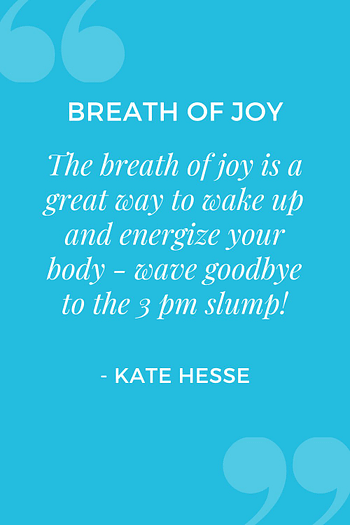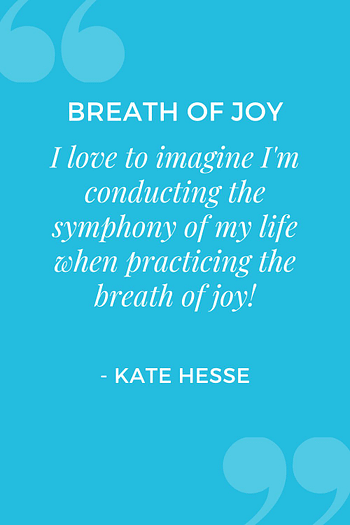
I love to practice the breath of joy. Every time I’m in a yoga class and the teacher asks us to stand at the top of our mats with our feet spaced wider than normal, I get excited thinking this might be where we’re heading. You can use this pranayama as part of a comprehensive yoga practice, or use it on it’s own anytime you need a boost of energy.
I particularly love this practice for the 3 pm slump!
The breath of joy is a great practice for waking up the body and getting your energy moving. It’s also just plain fun! But there are other benefits to getting your full body involved in this pranayama.
 Benefits of the breath of joy
Benefits of the breath of joy
This is an invigorating breath. It’s a great way to wake up the body either in the morning, or if you feel yourself getting groggy in the middle of the day. It also warms up the body and is a great way to get your agni (the fire or heat you build up during an asana practice) started at the beginning of a yoga practice.
The breath of joy can also be a lot of fun and always helps lift my mood. It might be a great thing to introduce to your self-care toolkit when you’re feeling a little blue. And it moves energy – so if you’re feeling anxious or agitated, this pranayama is a great option for helping to get that energy moving out of your body.
And because you’re using your full body, the breath of joy is a great technique to add to your practice for cardiovascular health.
The arm movements in this practice are very similar to those used by orchestra conductors. And a MetLife study conducted from 1956-1975 found that symphony conductors as a group had a death rate that was 38% lower than the general population. While I’m sure we can’t attribute that all just to arm movements, it’s a major part of their job which the rest of us do not do on a regular basis.
 Conducting your own private symphony
Conducting your own private symphony
I love to think of conducting the symphony of my life when I’m practicing the breath of joy. Just like in an actual orchestra, each instrument has a role or part to play. It doesn’t matter how beautifully the clarinet part is played, if the drums are playing so loud they drown it out. But when they all come together in harmonious balance, that’s where the magic happens.
The same applies to your own life – only when each aspect of your life is in balance with the others will you be living in harmony. You want to find a way to balance each role you play in your life so you are a beautiful and balanced song, and not a single instrument (or two) drowning out all the others.
While absolutely not necessary to practice this technique, consider deepening the impact as you practice the breath of joy by imagining all of your roles (work responsibilities, personal relationships, responsibilities to self, and all the things you do which nourish you) falling into a perfect harmony, equally balanced to create a beautiful song. As you move your arms, you’re conducting them to fall into alignment and balance with each other.
Practicing the breath of joy
This is another one of those practices where a picture is worth a thousand words! Here is a video demonstrating how to practice the breath of joy. Remember, the ultimate goal here is to have fun, give yourself permission to enjoy the practice.
Bonus Technique
This is another whole body practice that’s fantastic for helping you to move anger, frustration, and any other fiery energy out of your body. I learned this technique from an amazing energy and body worker who is trained in a number of modalities and I’m so grateful to have it as a tool in my toolbox!
While I don’t know the official name for this technique, I think of it as hammering a nail breath (although the visualization when I learned the technique was chopping with an axe). I turn to this breath when I’m at my wits end, when I’m so frustrated I just want to scream.
You might use it when you have been on hold for 45 minutes (listening to terrible muzak and someone promising they will be with you shortly) trying to get help sorting out a mistake on a bill, and you finally get connected to a human being only to be disconnected 30 seconds later.
Instead of screaming, or crying, or calling back and yelling at the first person you can get on the phone, or redirecting the frustration you feel by yelling at your partner or child for leaving a light on, or just shoving the anger down without allowing it to be recognized, try this technique!
While feeling those fiery emotions is not a bad thing, we run into trouble when we misdirect them or suppress them, refusing to give acknowledgement to what we are experiencing. It’s by being present with the emotion that we’re able to let it be heard, provide any lesson it’s trying to teach us, and then allow it to move out of our bodies.
When any emotions are pushed down into the body, they fester, and when they finally surface, they come out in a much yuckier way than if we had honored and processed them when the first arose. This technique allows you to be present with, and process, these emotions as they arise.
Contraindications
It’s important to remember that we are not cookie cutter humans and what works for one person may not be right for another.
If at any point you feel light headed, discontinue the practice immediately, carefully come to a seat, and return to your normal breath. Additionally, because both of these practices require rapid movement from standing to bent over, it’s not recommended for those who have eye or ear problems, and those with high blood pressure. Also, check with your physician if you are pregnant to determine if this practice is appropriate for you.
If you have any shoulder issues, use care when practicing either technique. These pranayama practices are about linking breath to movement and moving energy. They are not intended to test the limits of your flexibility. If you feel any physical pain, reduce your range of motion until the technique is physically within your comfort zone.
Finally, if you are in the midst of an anxiety attack or are working with active trauma (either big or little t), please know that these practices will get your energy moving and can amplify the feelings you are currently experiencing. Use these techniques with care and awareness to your own individual needs.
I would love to hear how these practices went for you. Please leave me a comment below.
And if you love the idea of all aspects of your life coming into harmonious balance but have no idea where to start, I would love to help!
Or if you find you are using the hammering a nail breath WAY more often than you’d like and wish someone could help you feel less frustrated by everything in your life, I am here to help with that too!
Click on over here and schedule your complimentary Discovery Session – you CAN live in healthy balance and build a life you love.
Related
One thought on “Breath of Joy – everything you need to know for full body pranayama”
Leave a Reply Cancel reply
This site uses Akismet to reduce spam. Learn how your comment data is processed.
[…] love the Breath of Joy for energizing during the mid-afternoon slump. I’ve got a video tutorial of this pranayama […]